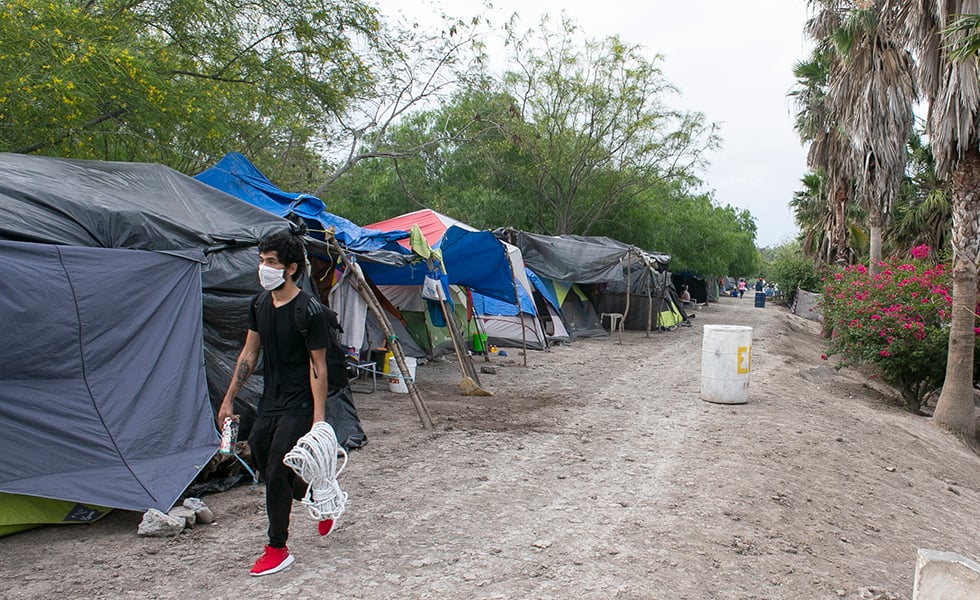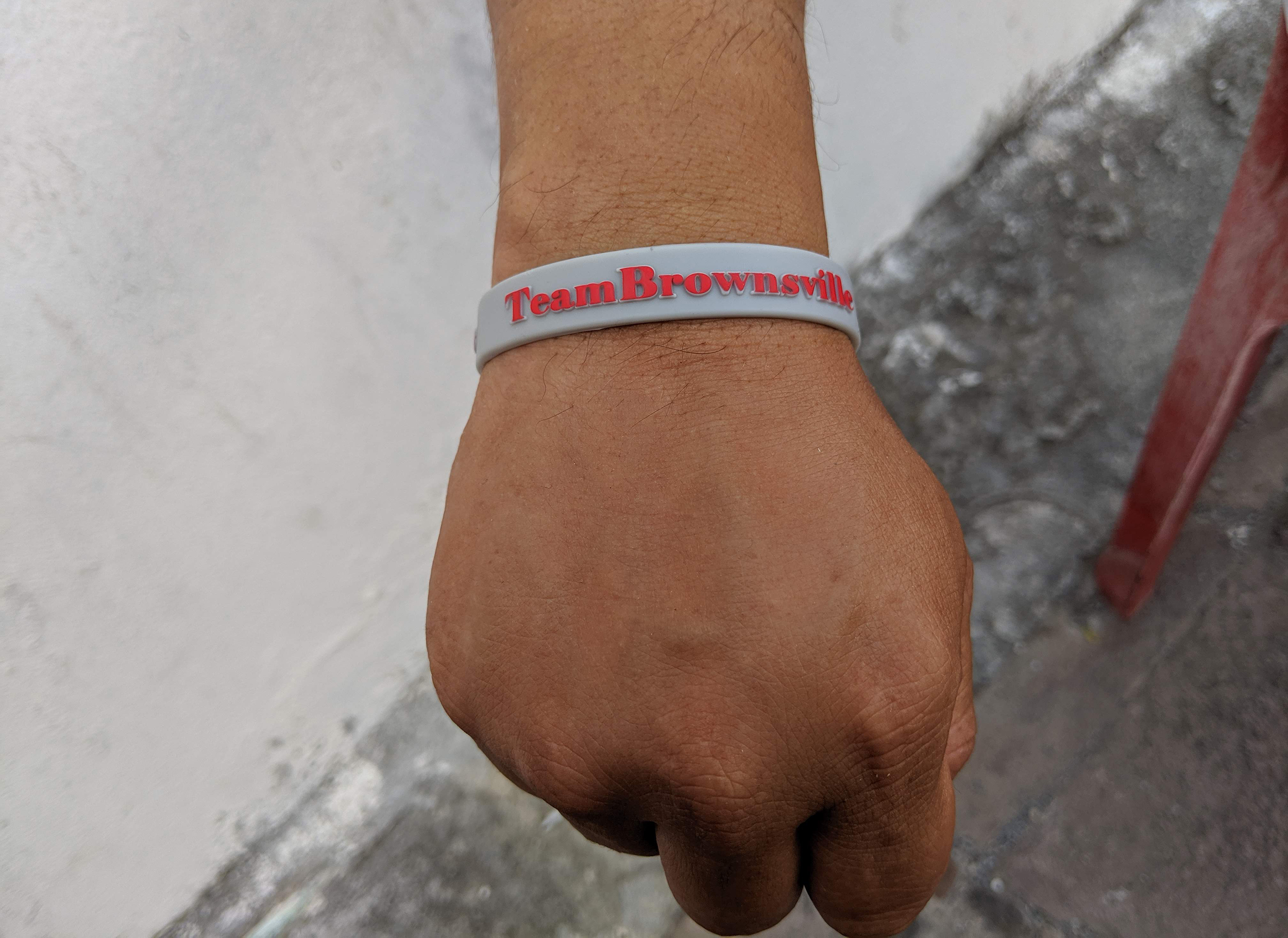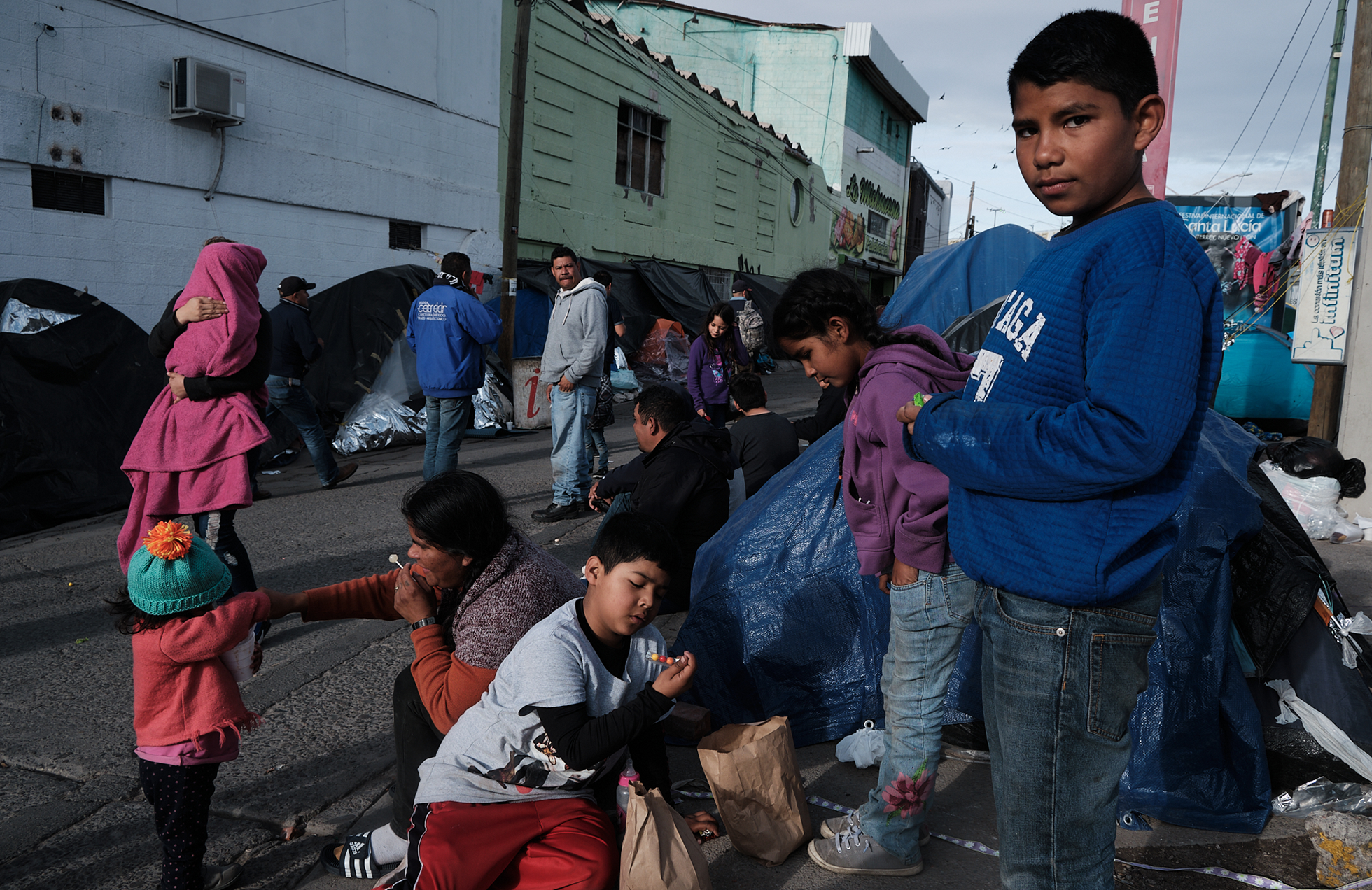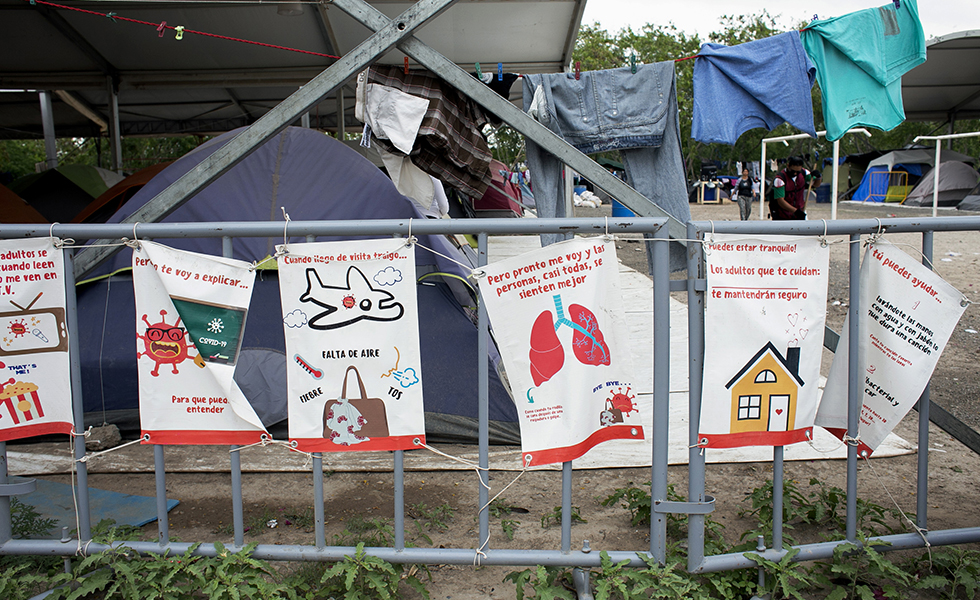
Feeding Refugees on the Texas Border Has Been Tough. Now There’s COVID-19.
Elizabeth “Lizee” Cavazos, who volunteers with Angry Tias and Abuelas of the Rio Grande Valley, talks about the challenges of arranging food for a refugee camp in Matamoros as the coronavirus keeps volunteers stateside.
Above: “We started to hear from the people that they missed their food. When you have displaced people, living in surroundings that are not familiar to them—they’re living in a tent—I think they had this yearning for something that was the same.”
Since 2019, a crisis has been unfolding directly across the U.S.-Mexico border from Brownsville. About 2,000 refugees, largely from Central America, have been stranded in a riverside encampment, wholly dependent on humanitarian groups for food and other basic needs. Feeding them before COVID-19 was a daunting task for the aid groups, most of which are based in the United States. The pandemic has made food delivery considerably more complicated.
The refugees had begun assembling in Matamoros, a city of about 550,000, in response to the Migrant Protection Protocols (MPP), a Trump administration policy unveiled in January 2019 that requires asylum-seekers to remain in Mexico until their cases are processed.
The encampment first materialized in a plaza near the Gateway International Bridge. Then it moved a few hundred feet up and over a levee and onto a flood-prone stretch of the Rio Bravo (the Mexican name for the Rio Grande). Officials and journalists who have visited the crowded tent city describe it as a humanitarian disaster. Residents bathe and wash their clothes in the polluted river. Many avoid the overflowing portable toilets. Doctors have treated influenza, pneumonia, toxoplasmosis, burns, malnutrition, and scabies.
As of earlier this week, the camp had no confirmed cases of COVID-19, although Matamoros itself had 272 cases. Health professionals worry that an outbreak in the tightly packed camp would be hard to contain.
Because the camp is not government-run, U.S. and Mexican organizations are helping provide food, clean water, medical care, and legal assistance. Among them are Catholic Charities of the Rio Grande Valley, the local aid groups Team Brownsville and Resource Center Matamoros, and chef José Andrés’ World Central Kitchen, which ran a dining tent in the encampment but now pays for a local restaurant to serve free cooked meals.

Another group of Texas volunteers, Angry Tias and Abuelas (Aunts and Grandmothers) of the Rio Grande Valley, provides many of the camp dwellers with familiar ingredients so they can cook their own food.
In a recent interview with FERN, the Tias’ Elizabeth “Lizee” Cavazos talked about the challenges of arranging food for the camp as the coronavirus keeps volunteers stateside. The interview was condensed and edited for clarity.
How have you seen the informal settlement evolve?
There was already a settlement happening in Matamoros before MPP: 20 people, 25 people. It was in this concrete area where the citizens of Matamoros used to hang out prior to crossing into the United States. Team Brownsville was serving that population, feeding them every night. After MPP hit, it started doubling in size, and doubling again, until the plaza became inundated with tents.
Now the whole encampment is on the other side of the levee. So you really can’t see it [from the city] unless you go up and over that levee, and it’s otherworldly when you do. These people are primitive camping. They have no running water. They have no electricity. They have no access to resources except for the ones that we are giving them.
Before the pandemic, what was your food delivery system like?
The Angry Tias, we find the gap in services and we fill it, like an auxiliary group. When we went into Matamoros, we saw that Team Brownsville was the most engaged with the feeding of the individuals. They were taking prepared food in wagons into Mexico: tuna casserole and spaghetti and many things that [the refugees] just weren’t accustomed to.
We started to hear from the people that they missed their food. When you have displaced people, living in surroundings that are not familiar to them—they’re living in a tent—I think they had this yearning for something that was the same. And the easiest thing to give them was access to some of the types of foods that they like.
We were spending about $1,000 a day between food and household items: detergent, Clorox, toilet paper, Pampers, toothbrushes, toothpaste. We knew we couldn’t sustain that. Then Team Brownsville, knight in shining armor, whisked in and said, “Hey, can we help you guys buy some of these food staples and household items?” And we said, “Yes, yes!”
Meanwhile, the refugees were building their own kitchens. How did they do that?
The bank of the river where this encampment is—it’s very clay-like. People took clay and mixed it with organic material to fashion their own stoves. They cut trees to create the base of the stove.
When you have, say, 2,000 people, you would be talking about maybe 600 family kitchens. There’s no way that that landscape could handle that. So they started to create communal kitchens.
How many kitchens are there?
About 150.
Could you tell me more about how the kitchens are used?
There are some basic staples that get made en masse at each communal kitchen, like the tortillas. And rice, beans, those things. Then each family will take their turn and make what we would consider the protein, or what they’re going to work the rest of the dishes around. But there are many times that all they do is eat tortillas and rice and beans.
They all utilize the same pots and pans. They clean up after themselves. But that fire is going all day long, which adds to a lot of smoke pollution in the camp and creates respiratory issues.
Are there other concerns about the environmental impact?
The organizations assisting the immigrants became very concerned with the number of plastic water bottles that were being used, and the cutting of the trees. But the alternative was either not within the parameters that [Mexican authorities] set for us, or it was just cost-prohibitive.
We tried to get permission to use a different type of cooker, like propane. Every alternative we posed, basically they put the kibosh on it. But they did say also, “Stop cutting our trees.” So we had to find an alternative supplier for firewood outside of the encampment.
Before COVID-19, how did you source the staples? And how did you transport them to the camp?
This didn’t come with a playbook. Our model started with making purchases in America and transporting in carts and sometimes trucks if we could.
One day, a [Mexican] customs guy would say, “No, you can’t. You need a letter.” It became hit-or-miss. Sometimes we could get through with lots of carts; sometimes not. So then we started to think, “This isn’t working anymore. The camp has grown so substantially. We can’t afford not to get these things over on a timely basis.”
That’s when we shifted the model to purchasing in Matamoros. We found that Matamoros is a huge city with all the same stores that we have. So we thought: “Let’s just go make the purchases there and then bring them to the encampment.” That would also be a way that we could contribute to the city. Maybe we could foster some goodwill with the citizens and the business owners of Matamoros.
Help me understand why the migrants could not shop on their own.
Money is probably the biggest issue. But there is also an element of danger. You’re talking about an area that [the U.S. State Department] classifies as a no-visit zone. And this is already a very vulnerable population. I think that the majority of them hesitated to venture beyond the security of that area.
As you began hearing news of the spreading pandemic, what were the conversations like about shifting the model if you could no longer physically access the camp?
Before COVID, we had decided with Team Brownsville that we needed to purchase shipping containers, two of them, and put them in the encampment to create an access point. The whole situation was already very tenuous. We are strangers. We are there because we are being allowed to be there.
We never imagined COVID, but it’s the same end result: We cannot be in the encampment. Thank goodness we had already created a system.
How does the new system work?
We found a woman who sources everything for us. We give her the list of food. She finds local sources for it. She purchases it. We pay for it. She gets it transported to the encampment. We have people there who put it into the containers.
We’ve had constant communication via WhatsApp with the encampment. A kitchen will say, “Hey, we’re out of beans.” There’s not a day that I’m not engaged with the encampment at this point.
Has COVID-19 presented other challenges?
We’ve started to have this influx of people coming in to ask for the provisions: the indigent population from the surrounding area, and other refugees who had integrated into the city but lost their jobs due to COVID. And that’s a fear for us: They could be bringing the virus into the encampment. We’ve always had people trickle in from outside, and that hasn’t been an issue. But with the possibility of contagion, now it’s like, “No, don’t come into the encampment to get your provisions. Let’s get you the food that you need without you physically coming in.”
You’ve emphasized the importance of collaboration, not just with other groups providing food but also with partners providing medical care and clean water. What’s the value of these partnerships?
We recognized early on that all of this fits together, and all of this matters. We need to put our funding to benefit all of these different things so that the person, the whole person, can sustain the worst of circumstances.
When I step back from this and I allow myself to look at the panorama, it is so overwhelming. And it’s so devastating. And it’s so beautiful.
This story was produced by the Food & Environment Reporting Network and is reprinted with permission.
Find all of our coronavirus coverage here.
Read more from the Observer:
-
Home Wasn’t Safe. Then COVID-19 Made It Seem Like the Only Option: Seeing a “disturbing” decrease in clients and callers amid COVID-19 stay-at-home orders, some domestic violence shelters in rural counties worry this is just the “calm before the storm.”
-
Raise a Glass to the Class of COVID-19: Maybe they will help build a post-pandemic world (or so I hope).
-
Locked Out: Visitation is a critical lifeline for incarcerated people, yet some families say Texas prison officials ban them from seeing loved ones over petty or unproven claims of misconduct.

